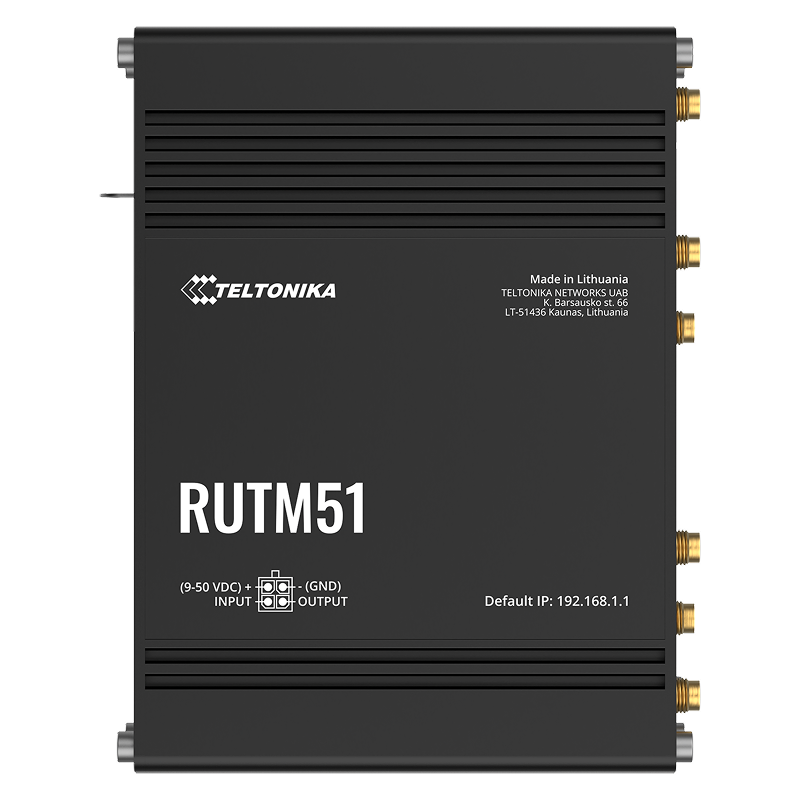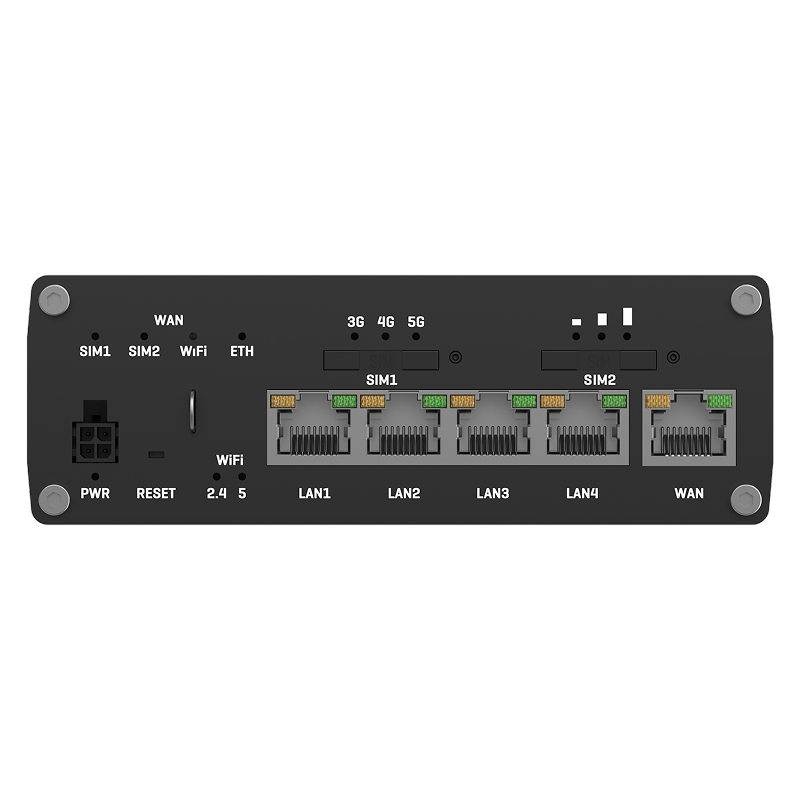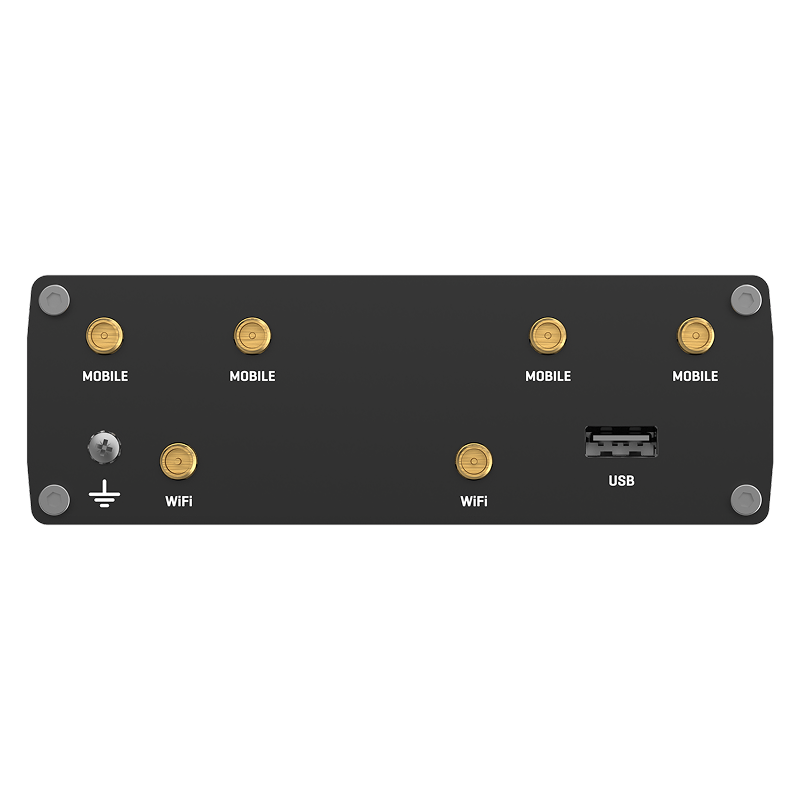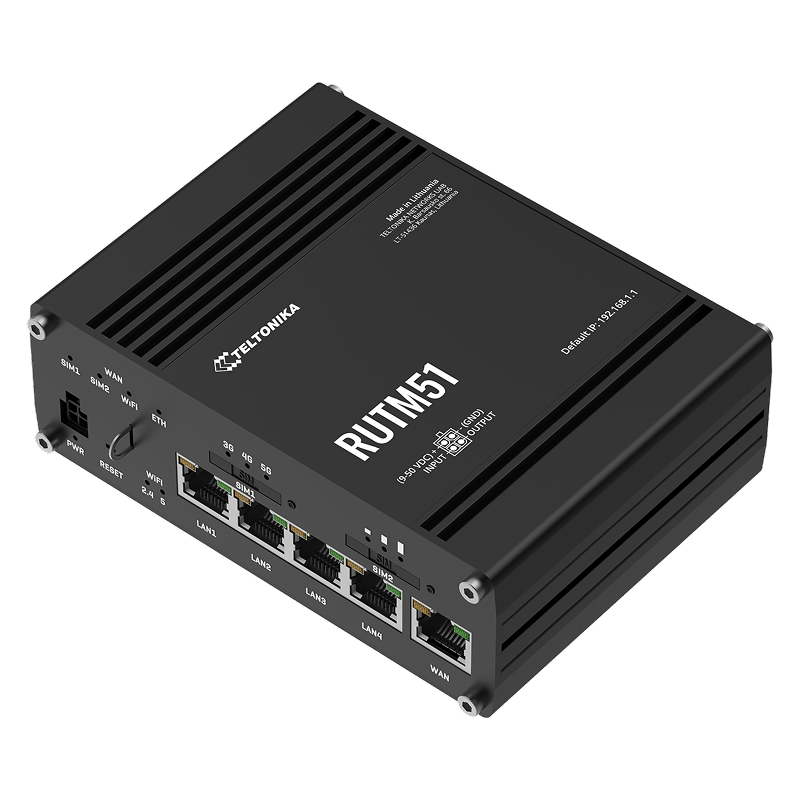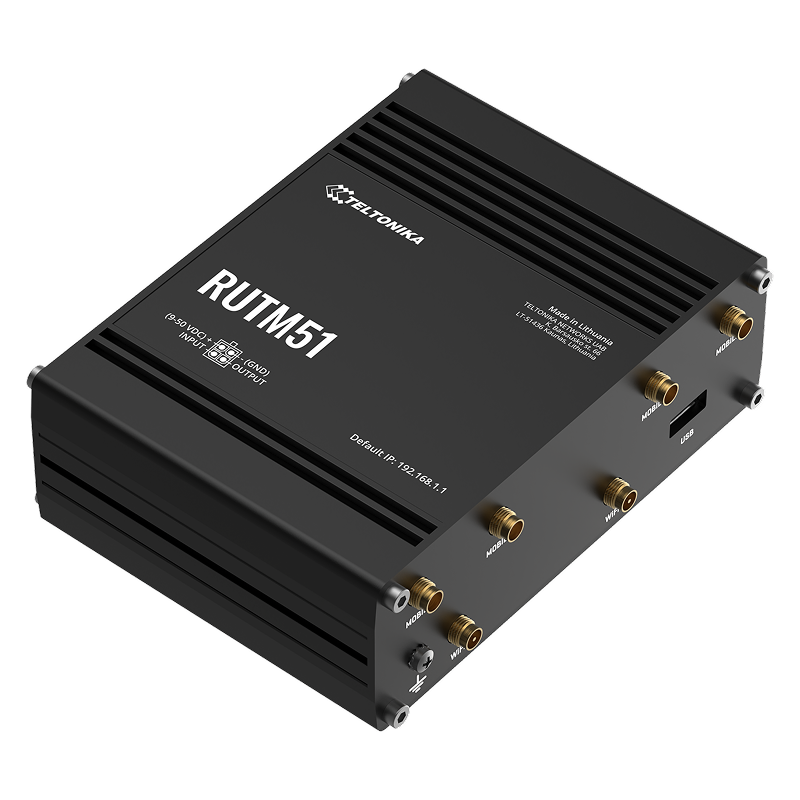




Tekniska specifikationer
Mobile
Cellular module: 4G LTE Cat 4 up to 150 DL / 50 UL Mbps; 3G up to 21 DL / 5.76 UL Mbps; 2G up to 236.8 DL / 236.8 UL kbps
3GPP Release: Release 10/11 depending on hardware version
eSIM*: Consumer-grade eSIM, profile download and deletion, up to 7 eSIM profiles; does not include data plans
*Feature availability varies depending on order code
SIM switch*: 1 x 2FF SIM and 1 x eSIM, automatic switching in case of: weak signal, data limit, SMS limit, roaming, no network, network denied, data connection error
*Feature availability varies depending on order code
Status: IMSI, ICCID, operator, operator state, data connection status, network type, bandwidth, connected band, signal strength (RSSI), SINR, RSRP, RSRQ, EC/IO, RSCP, data sent/received, LAC, TAC, cell ID, ARFCN, UARFCN, EARFCN, MCC and MNC
SMS: SMS status, SMS configuration, Email to SMS, SMS to Email, SMS to HTTP, SMS to SMS, scheduled SMS, SMS auto-reply, SMPP
USSD: Support for sending and reading USSD messages
Block/Allow List: Operator Block/Allow List (per country or individual operators)
Multiple PDNs: Ability to use different PDNs for multiple network accesses and services
Tape management: Tape lock, display of used tape status
SIM PIN management: Ability to set, change or disable the SIM card PIN
APN: Automatic APN
Bridge: Direct connection (bridge) between mobile ISP and device on LAN
Passthrough: The router assigns its mobile WAN IP address to another device on the LAN
3GPP Release: Release 10/11 depending on hardware version
eSIM*: Consumer-grade eSIM, profile download and deletion, up to 7 eSIM profiles; does not include data plans
*Feature availability varies depending on order code
SIM switch*: 1 x 2FF SIM and 1 x eSIM, automatic switching in case of: weak signal, data limit, SMS limit, roaming, no network, network denied, data connection error
*Feature availability varies depending on order code
Status: IMSI, ICCID, operator, operator state, data connection status, network type, bandwidth, connected band, signal strength (RSSI), SINR, RSRP, RSRQ, EC/IO, RSCP, data sent/received, LAC, TAC, cell ID, ARFCN, UARFCN, EARFCN, MCC and MNC
SMS: SMS status, SMS configuration, Email to SMS, SMS to Email, SMS to HTTP, SMS to SMS, scheduled SMS, SMS auto-reply, SMPP
USSD: Support for sending and reading USSD messages
Block/Allow List: Operator Block/Allow List (per country or individual operators)
Multiple PDNs: Ability to use different PDNs for multiple network accesses and services
Tape management: Tape lock, display of used tape status
SIM PIN management: Ability to set, change or disable the SIM card PIN
APN: Automatic APN
Bridge: Direct connection (bridge) between mobile ISP and device on LAN
Passthrough: The router assigns its mobile WAN IP address to another device on the LAN
Wireless
Wireless mode: 802.11b/g/n/ac Wave 2 (Wi-Fi 5) with data transfer rates up to 867 Mbps (Dual Band, MU-MIMO), 802.11r fast handover, Access Point (AP), Station (STA)
Wi-Fi Security: WPA2-Enterprise: PEAP, WPA2-PSK, WPA-EAP, WPA-PSK, WPA3-SAE, WPA3-EAP, OWE; AES-CCMP, TKIP, Automatic encryption modes, client separation, EAP-TLS with PKCS#12 certificate, disable auto-reconnect, 802.11w Protected Management Frames (PMF)
SSID/ESSID: ESSID hidden mode
Wi-Fi users: Up to 150 simultaneous connections
Wireless connectivity features: Wireless mesh (802.11s), fast roaming (802.11r), Relayd, BSS transition management (802.11v), radio source metering (802.11k)
Wireless MAC filter: Allow list, block list
Wireless QR code generator: When scanned, the user is automatically connected to the network without having to enter login credentials
TravelMate: Forwards the Wi-Fi hotspot home page to the next connected device
Wi-Fi Security: WPA2-Enterprise: PEAP, WPA2-PSK, WPA-EAP, WPA-PSK, WPA3-SAE, WPA3-EAP, OWE; AES-CCMP, TKIP, Automatic encryption modes, client separation, EAP-TLS with PKCS#12 certificate, disable auto-reconnect, 802.11w Protected Management Frames (PMF)
SSID/ESSID: ESSID hidden mode
Wi-Fi users: Up to 150 simultaneous connections
Wireless connectivity features: Wireless mesh (802.11s), fast roaming (802.11r), Relayd, BSS transition management (802.11v), radio source metering (802.11k)
Wireless MAC filter: Allow list, block list
Wireless QR code generator: When scanned, the user is automatically connected to the network without having to enter login credentials
TravelMate: Forwards the Wi-Fi hotspot home page to the next connected device
Ethernet
WAN: 1 x WAN port 10/100/1000 Mbps, compatible with IEEE 802.3, IEEE 802.3u, 802.3az standards, supports auto MDI/MDIX crossover
LAN: 4 x LAN ports, 10/100/1000 Mbps, compatible with IEEE 802.3, IEEE 802.3u, 802.3az standards, supports auto MDI/MDIX crossover
LAN: 4 x LAN ports, 10/100/1000 Mbps, compatible with IEEE 802.3, IEEE 802.3u, 802.3az standards, supports auto MDI/MDIX crossover
Nätverk
Routing: Statisk routing, Dynamisk routing (BGP, OSPF v2, RIP v1/v2, EIGRP, NHRP), Policybaserad routing
Nätverksprotokoll: TCP, UDP, IPv4, IPv6, ICMP, NTP, DNS, HTTP, HTTPS, SFTP, FTP, SMTP, SSL/TLS, ARP, VRRP, PPP, PPPoE, UPNP, SSH, DHCP, Telnet, SMPP, SNMP, MQTT, Wake On Lan (WOL), VXLAN
VoIP passthrough support: H.323 och SIP-alg protokoll NAT-hjälpare som möjliggör korrekt routing av VoIP-paket
Anslutningsövervakning: Ping Reboot, Wget Reboot, Periodisk Reboot, LCP och ICMP för länkinspektion
Brandvägg: Port forwarding, trafikregler, egna regler, TTL-mål anpassning
Brandvägg status sida: Visa all din brandväggsstatistik, regler och regelräknare
Porthantering: Visa enhetens portar, aktivera och inaktivera dem, slå på eller av auto-konfiguration, ändra överföringshastighet med mera
Nätverkstopologi: Visuell representation av ditt nätverk, visar vilka enheter som är kopplade till vilka andra enheter
DHCP: Statisk och dynamisk IP-tilldelning, DHCP-relä, DHCP-serverkonfiguration, status, statiska leasingar: MAC med jokertecken
QoS / Smart Queue Management (SQM): Trafikprioritering via köhantering efter källa/destination, tjänst, protokoll eller port, WMM, 802.11e
DDNS: Stöder >25 tjänsteleverantörer, andra kan konfigureras manuellt
DNS över HTTPS: DNS över HTTPS-proxy möjliggör säker DNS-upplösning genom att routa DNS-förfrågningar över HTTPS
Nätverksbackup: Wi-Fi WAN, Mobil, VRRP, Trådbundna alternativ, som alla kan användas som automatisk failover
Lastbalansering: Balans av internettrafik över flera WAN-anslutningar
Hotspot: Captive portal (hotspot), intern/extern Radius-server, Radius MAC-autentisering, SMS-auktorisation, SSO-autentisering, intern/extern landningssida, walled garden, användarskript, URL-parametrar, användargrupper, individuella användar- eller gruppbegränsningar, användarhantering, 9 standardanpassningsbara teman och möjlighet att ladda upp/ned teman
SSHFS: Möjlighet att montera fjärrfilsystem via SSH-protokoll
VRF support: Grundläggande stöd för virtuell routing och vidarebefordran (VRF)
Trafikhantering: Övervakning i realtid, trådlösa signaldiagram, historik över trafikförbrukning
Nätverksprotokoll: TCP, UDP, IPv4, IPv6, ICMP, NTP, DNS, HTTP, HTTPS, SFTP, FTP, SMTP, SSL/TLS, ARP, VRRP, PPP, PPPoE, UPNP, SSH, DHCP, Telnet, SMPP, SNMP, MQTT, Wake On Lan (WOL), VXLAN
VoIP passthrough support: H.323 och SIP-alg protokoll NAT-hjälpare som möjliggör korrekt routing av VoIP-paket
Anslutningsövervakning: Ping Reboot, Wget Reboot, Periodisk Reboot, LCP och ICMP för länkinspektion
Brandvägg: Port forwarding, trafikregler, egna regler, TTL-mål anpassning
Brandvägg status sida: Visa all din brandväggsstatistik, regler och regelräknare
Porthantering: Visa enhetens portar, aktivera och inaktivera dem, slå på eller av auto-konfiguration, ändra överföringshastighet med mera
Nätverkstopologi: Visuell representation av ditt nätverk, visar vilka enheter som är kopplade till vilka andra enheter
DHCP: Statisk och dynamisk IP-tilldelning, DHCP-relä, DHCP-serverkonfiguration, status, statiska leasingar: MAC med jokertecken
QoS / Smart Queue Management (SQM): Trafikprioritering via köhantering efter källa/destination, tjänst, protokoll eller port, WMM, 802.11e
DDNS: Stöder >25 tjänsteleverantörer, andra kan konfigureras manuellt
DNS över HTTPS: DNS över HTTPS-proxy möjliggör säker DNS-upplösning genom att routa DNS-förfrågningar över HTTPS
Nätverksbackup: Wi-Fi WAN, Mobil, VRRP, Trådbundna alternativ, som alla kan användas som automatisk failover
Lastbalansering: Balans av internettrafik över flera WAN-anslutningar
Hotspot: Captive portal (hotspot), intern/extern Radius-server, Radius MAC-autentisering, SMS-auktorisation, SSO-autentisering, intern/extern landningssida, walled garden, användarskript, URL-parametrar, användargrupper, individuella användar- eller gruppbegränsningar, användarhantering, 9 standardanpassningsbara teman och möjlighet att ladda upp/ned teman
SSHFS: Möjlighet att montera fjärrfilsystem via SSH-protokoll
VRF support: Grundläggande stöd för virtuell routing och vidarebefordran (VRF)
Trafikhantering: Övervakning i realtid, trådlösa signaldiagram, historik över trafikförbrukning
Security
Authentication: Distributed key, digital certificates, X.509 certificates, TACACS+, internal & external RADIUS user authentication, IP and login attempt blocking, time-based login blocking, built-in random password generator
Firewall: Pre-configured firewall rules can be enabled via WebUI, unlimited firewall configuration via CLI, DMZ, NAT, NAT-T, NAT64
Attack prevention: DDOS protection (SYN flood protection, SSH attack prevention, HTTP/HTTPS attack prevention), port scan protection (SYN-FIN, SYN-RST, X-mas, NULL flags, FIN scan attacks)
VLAN: Port and tag-based VLAN separation
Mobile quota control: Mobile data limit, customizable period, start time, warning limit, phone number
WEB filter: Blacklist to block unwanted websites, whitelist to specify only allowed websites
Access Control: Flexible access control for SSH, web interface, CLI and Telnet
SSL certificate generation: Let's Encrypt and SCEP certificate generation methods
802.1x: Port-based network access control client
Firewall: Pre-configured firewall rules can be enabled via WebUI, unlimited firewall configuration via CLI, DMZ, NAT, NAT-T, NAT64
Attack prevention: DDOS protection (SYN flood protection, SSH attack prevention, HTTP/HTTPS attack prevention), port scan protection (SYN-FIN, SYN-RST, X-mas, NULL flags, FIN scan attacks)
VLAN: Port and tag-based VLAN separation
Mobile quota control: Mobile data limit, customizable period, start time, warning limit, phone number
WEB filter: Blacklist to block unwanted websites, whitelist to specify only allowed websites
Access Control: Flexible access control for SSH, web interface, CLI and Telnet
SSL certificate generation: Let's Encrypt and SCEP certificate generation methods
802.1x: Port-based network access control client
VPN
OpenVPN: Multiple clients and one server can run simultaneously, 27 encryption methods
OpenVPN encryption: DES-CBC 64, RC2-CBC 128, DES-EDE-CBC 128, DES-EDE3-CBC 192, DESX-CBC 192,
BF-CBC 128, RC2-40-CBC 40, CAST5-CBC 128, RC2-64-CBC 64, AES-128-CBC 128, AES-128-CFB 128, AES-128-CFB1 128, AES-128-CFB8 128, AES-128-OFB 128, AES-128-GCM 128, AES-192-CFB 192, AES-192-CFB1 192, AES-192-CFB8 192, AES-192-OFB 192, AES-192-CBC 192, AES-192-GCM 192, AES-256-GCM 256, AES-256-CFB 256, AES-256-CFB1 256, AES-256-CFB8 256, AES-256-OFB 256, AES-256-CBC 256
IPsec: XFRM, IKEv1, IKEv2, with 14 IPsec encryption methods (3DES, DES, AES128, AES192, AES256, AES128GCM8, AES192GCM8, AES256GCM8, AES128GCM12, AES192GCM12, AES256GCM12, AES128GCM16, AES192GCM16, AES256GCM16)
GRE: GRE tunnel, GRE tunnel over IPsec support
PPTP, L2TP: Client/server instance can run simultaneously, L2TPv3, L2TP over IPsec support
Stunnel<. Proxy designed to add TLS encryption to existing clients and servers without changes to the application's code
DMVPN: Method for building scalable IPsec VPNs, supporting Phase 2 and Phase 3 as well as Dual Hub
SSTP: SSTP client instance support
ZeroTier: ZeroTier VPN client support
WireGuard: Support for WireGuard VPN client and server
Tinc: Tinc offers encryption, authentication, and compression in its tunnels. Client and server support.
Tailscale: Tailscale offers speed, stability, and simplicity over traditional VPNs. Encrypted point-to-point connections using the open-source WireGuard protocol
OpenVPN encryption: DES-CBC 64, RC2-CBC 128, DES-EDE-CBC 128, DES-EDE3-CBC 192, DESX-CBC 192,
BF-CBC 128, RC2-40-CBC 40, CAST5-CBC 128, RC2-64-CBC 64, AES-128-CBC 128, AES-128-CFB 128, AES-128-CFB1 128, AES-128-CFB8 128, AES-128-OFB 128, AES-128-GCM 128, AES-192-CFB 192, AES-192-CFB1 192, AES-192-CFB8 192, AES-192-OFB 192, AES-192-CBC 192, AES-192-GCM 192, AES-256-GCM 256, AES-256-CFB 256, AES-256-CFB1 256, AES-256-CFB8 256, AES-256-OFB 256, AES-256-CBC 256
IPsec: XFRM, IKEv1, IKEv2, with 14 IPsec encryption methods (3DES, DES, AES128, AES192, AES256, AES128GCM8, AES192GCM8, AES256GCM8, AES128GCM12, AES192GCM12, AES256GCM12, AES128GCM16, AES192GCM16, AES256GCM16)
GRE: GRE tunnel, GRE tunnel over IPsec support
PPTP, L2TP: Client/server instance can run simultaneously, L2TPv3, L2TP over IPsec support
Stunnel<. Proxy designed to add TLS encryption to existing clients and servers without changes to the application's code
DMVPN: Method for building scalable IPsec VPNs, supporting Phase 2 and Phase 3 as well as Dual Hub
SSTP: SSTP client instance support
ZeroTier: ZeroTier VPN client support
WireGuard: Support for WireGuard VPN client and server
Tinc: Tinc offers encryption, authentication, and compression in its tunnels. Client and server support.
Tailscale: Tailscale offers speed, stability, and simplicity over traditional VPNs. Encrypted point-to-point connections using the open-source WireGuard protocol
OPC UA
Supported modes: Client, Server
Supported connection types: TCP
Supported connection types: TCP
MODBUS
Supported modes: Server, Client
Supported connection types: TCP, USB
Custom registers: MODBUS TCP custom register block requests, which read/write to a file in the router, and can be used to extend the functionality of the MODBUS TCP client
Supported data formats: 8-bit: INT, UINT; 16-bit: INT, UINT (MSB or LSB first); 32-bit: float, INT, UINT (ABCD (big-endian), DCBA (little-endian), CDAB, BADC), HEX, ASCII
Supported connection types: TCP, USB
Custom registers: MODBUS TCP custom register block requests, which read/write to a file in the router, and can be used to extend the functionality of the MODBUS TCP client
Supported data formats: 8-bit: INT, UINT; 16-bit: INT, UINT (MSB or LSB first); 32-bit: float, INT, UINT (ABCD (big-endian), DCBA (little-endian), CDAB, BADC), HEX, ASCII
DATA TO SERVER
Protocol: HTTP(S), MQTT, Azure MQTT
Data to Server: Extract parameters from multiple sources and different protocols, and send everything to a single server; Custom LUA scripting that allows scripts to use the router's Data to Server feature
Data to Server: Extract parameters from multiple sources and different protocols, and send everything to a single server; Custom LUA scripting that allows scripts to use the router's Data to Server feature
MQTT Gateway
Modbus MQTT Gateway: Allows sending commands and receiving data from MODBUS server via MQTT broker
DNP3
Supported modes: Station, Outstation
Supported connections: TCP, USB
Supported connections: TCP, USB
DLMS/COSEM
DLMS support: DLMS – standard protocol for exchanging meter data
Supported modes: Client
Supported connection types: TCP
COSEM: Ability to scan the meter's COSEM object for automatic discovery and configuration
Supported modes: Client
Supported connection types: TCP
COSEM: Ability to scan the meter's COSEM object for automatic discovery and configuration
API
Teltonika Networks Web API (beta) support: Extend your device's capabilities by using a set of configurable API endpoints to retrieve or modify data. For more information, please see this documentation: https://developers.teltonika-networks.com
Monitoring & Management
WEB UI: HTTP/HTTPS, status, configuration, firmware update, CLI, troubleshooting, multiple event log servers, firmware update notifications, event log, system log, kernel log, internet status
FOTA: Firmware update from server, automatic notification
SSH: SSH (v1, v2)
SMS: SMS status, SMS configuration
Calls: Restart, status, mobile data on/off, output on/off, answer/hang up with timer, Wi-Fi on/off
TR-069: OpenACS, EasyCwmp, ACSLite, tGem, LibreACS, GenieACS, FreeACS, LibCWMP, Friendly tech, AVSystem
MQTT: MQTT Broker, MQTT publisher
SNMP: SNMP (v1, v2, v3), SNMP Trap, brute force protection
JSON-RPC: Management API over HTTP/HTTPS
MODBUS: MODBUS TCP status/control
RMS: Teltonika Remote Management System (RMS)
FOTA: Firmware update from server, automatic notification
SSH: SSH (v1, v2)
SMS: SMS status, SMS configuration
Calls: Restart, status, mobile data on/off, output on/off, answer/hang up with timer, Wi-Fi on/off
TR-069: OpenACS, EasyCwmp, ACSLite, tGem, LibreACS, GenieACS, FreeACS, LibCWMP, Friendly tech, AVSystem
MQTT: MQTT Broker, MQTT publisher
SNMP: SNMP (v1, v2, v3), SNMP Trap, brute force protection
JSON-RPC: Management API over HTTP/HTTPS
MODBUS: MODBUS TCP status/control
RMS: Teltonika Remote Management System (RMS)
IoT platforms
ThingWorx: Enables monitoring of: WAN type, WAN IP, mobile carrier name, mobile signal strength, mobile network type
Cumulocity - Cloud of Things: Enables monitoring of: device model, revision and serial number, WAN type and IP, mobile cell ID, ICCID, IMEI, connection type, operator, signal strength. Has actions for reboot and firmware upgrade
Azure IoT Hub: Can be configured with Data to Server to send all available parameters to the cloud. Supports Direct Method which allows to run RutOS API calls on IoT Hub. Also has Plug and Play integration with Device Provisioning Service which enables automatic device registration to IoT Hub without manual management
AWS IoT Core: Tools for interacting with the AWS cloud platform. Jobs support: Call the device API using AWS Jobs functionality
Cumulocity - Cloud of Things: Enables monitoring of: device model, revision and serial number, WAN type and IP, mobile cell ID, ICCID, IMEI, connection type, operator, signal strength. Has actions for reboot and firmware upgrade
Azure IoT Hub: Can be configured with Data to Server to send all available parameters to the cloud. Supports Direct Method which allows to run RutOS API calls on IoT Hub. Also has Plug and Play integration with Device Provisioning Service which enables automatic device registration to IoT Hub without manual management
AWS IoT Core: Tools for interacting with the AWS cloud platform. Jobs support: Call the device API using AWS Jobs functionality
System properties
CPU: MediaTek, Dual-core, 880 MHz, MIPS1004Kc
RAM: 256MB, DDR3
FLASH storage: 16 MB serial NOR flash, 256 MB serial NAND flash
RAM: 256MB, DDR3
FLASH storage: 16 MB serial NOR flash, 256 MB serial NAND flash
Firmware / Configuration
WEB UI: Update firmware from file, check firmware on server, configuration profiles, backup configuration
FOTA: Update firmware
RMS: Update firmware/configuration for multiple devices at once
Keep settings: Update firmware without losing current configuration
Factory Reset: A full factory reset will restore all system settings, including IP address, PIN, and user data to the manufacturer's default configuration.
FOTA: Update firmware
RMS: Update firmware/configuration for multiple devices at once
Keep settings: Update firmware without losing current configuration
Factory Reset: A full factory reset will restore all system settings, including IP address, PIN, and user data to the manufacturer's default configuration.
FIRMWARE CUSTOMIZATION
Operating system: RutOS (OpenWrt-based Linux OS)
Supported languages: Busybox shell, Lua, C, C++
Development tools: SDK package with build environment available
GPL Customization: You can create your own custom, branded firmware and web application by changing colors, logos, and other elements of our firmware to suit your or your customers' needs
Package Manager: The package manager is a service used to install additional software on the device
Supported languages: Busybox shell, Lua, C, C++
Development tools: SDK package with build environment available
GPL Customization: You can create your own custom, branded firmware and web application by changing colors, logos, and other elements of our firmware to suit your or your customers' needs
Package Manager: The package manager is a service used to install additional software on the device
USB
Data speed: USB 2.0
Applications: Samba sharing, USB-to-serial
External devices: Possibility to connect external HDD, flash memory, extra modem, printer, USB-serial adapter
Storage formats: FAT, FAT32, exFAT, NTFS (read only), ext2, ext3, ext4
Applications: Samba sharing, USB-to-serial
External devices: Possibility to connect external HDD, flash memory, extra modem, printer, USB-serial adapter
Storage formats: FAT, FAT32, exFAT, NTFS (read only), ext2, ext3, ext4
Input/Output
Input: 1 x Digital input, 0 - 6 V detected as logic low, 8 - 50 V detected as logic high
Output: 1 x Digital output, Open collector, max output 50 V, 300 mA
Events: Email, RMS, SMS
I/O juggler: Ability to set certain I/O conditions to initiate events
Output: 1 x Digital output, Open collector, max output 50 V, 300 mA
Events: Email, RMS, SMS
I/O juggler: Ability to set certain I/O conditions to initiate events
Power
Connection: 4-pin industrial DC power connector
Input voltage: 9 – 50 VDC, reverse polarity protection, overvoltage protection >51 VDC 10 µs max
PoE (passive): Ability to supply power via the LAN1 port, not compatible with IEEE802.3af, 802.3at and 802.3bt standards, Mode B, 9 - 50 VDC
Power Consumption: Sleep: <5 W, Max: <18 W
Input voltage: 9 – 50 VDC, reverse polarity protection, overvoltage protection >51 VDC 10 µs max
PoE (passive): Ability to supply power via the LAN1 port, not compatible with IEEE802.3af, 802.3at and 802.3bt standards, Mode B, 9 - 50 VDC
Power Consumption: Sleep: <5 W, Max: <18 W
Physical interfaces
Ethernet: 5 x RJ45 ports, 10/100/1000 Mbps
I/O: 1 x Digital input, 1 x Digital output on 4-pin power connector
Status LEDs: 4 x WAN type, 3 x Mobile connection type, 3 x Mobile connection strength, 10 x Ethernet port status, 1 x Power, 2 x 2.4G and 5G Wi-Fi
SIM: 2 x SIM card slots (Mini SIM – 2FF), 1.8 V/3 V
Power: 1 x 4-pin power connector
Antennas: 4 x SMA for cellular, 2 x RP-SMA for Wi-Fi
USB: 1 x USB A port for external devices
Reset: Restart/Restore User Defaults/Restore Factory Settings button
Other: 1 x Ground screw
I/O: 1 x Digital input, 1 x Digital output on 4-pin power connector
Status LEDs: 4 x WAN type, 3 x Mobile connection type, 3 x Mobile connection strength, 10 x Ethernet port status, 1 x Power, 2 x 2.4G and 5G Wi-Fi
SIM: 2 x SIM card slots (Mini SIM – 2FF), 1.8 V/3 V
Power: 1 x 4-pin power connector
Antennas: 4 x SMA for cellular, 2 x RP-SMA for Wi-Fi
USB: 1 x USB A port for external devices
Reset: Restart/Restore User Defaults/Restore Factory Settings button
Other: 1 x Ground screw
Physical specification
Housing material: Aluminum
Dimensions (W x H x D): 132 x 44.2 x 95 mm
Weight: 525g
Mounting options: DIN rail, wall mount, flat surface (all require accessory kit)
Dimensions (W x H x D): 132 x 44.2 x 95 mm
Weight: 525g
Mounting options: DIN rail, wall mount, flat surface (all require accessory kit)
Operating environment
Operating temperature: -40°C to 75°C
Operating humidity: 10% to 90% non-condensing
Protection class: IP30
Operating humidity: 10% to 90% non-condensing
Protection class: IP30
Regulatory and Type Approvals
CE, UKCA, EAC, UCRF, RCM, WEEE, CB
EMC emissions and immunity
Standards: EN 55032:2015+ A11:2020 + A1:2020
EN 55035:2017+A11:2020
EN 61000-3-3:2013+A1:2019+A2:2021
EN IEC 61000-3-2:2019+A1:2021
EN 301 489-1 V2.2.3
EN 301 489-3 V2.3.2
EN 301 489-17 V3.2.4
EN 301 489-52 V1.2.1
AS/NZS CISPR 32:2015+A1:2020
ESD: EN 55032:2015+ A11:2020 + A1:2020
EN 55035:2017+A11:2020
EN 61000-3-3:2013+A1:2019+A2:2021
EN IEC 61000-3-2:2019+A1:2021
EN 301 489-1 V2.2.3
EN 301 489-3 V2.3.2
EN 301 489-17 V3.2.4
EN 301 489-52 V1.2.1
AS/NZS CISPR 32:2015+A1:2020
Radiation immunity: EN 61000-4-3:2006 + A1:2008 + A2:2010, EN IEC 61000-4-3:2020
EFT: EN 61000-4-4:2012, EN 61000-4-4:2012
Surge protection (AC mains port): EN 61000-4-5:2014+A1:2017, EN 61000-4-5:2014+A1:2017
CS: EN 61000-4-6:2014
DIP: EN 61000-4-11:2020
EN 55035:2017+A11:2020
EN 61000-3-3:2013+A1:2019+A2:2021
EN IEC 61000-3-2:2019+A1:2021
EN 301 489-1 V2.2.3
EN 301 489-3 V2.3.2
EN 301 489-17 V3.2.4
EN 301 489-52 V1.2.1
AS/NZS CISPR 32:2015+A1:2020
ESD: EN 55032:2015+ A11:2020 + A1:2020
EN 55035:2017+A11:2020
EN 61000-3-3:2013+A1:2019+A2:2021
EN IEC 61000-3-2:2019+A1:2021
EN 301 489-1 V2.2.3
EN 301 489-3 V2.3.2
EN 301 489-17 V3.2.4
EN 301 489-52 V1.2.1
AS/NZS CISPR 32:2015+A1:2020
Radiation immunity: EN 61000-4-3:2006 + A1:2008 + A2:2010, EN IEC 61000-4-3:2020
EFT: EN 61000-4-4:2012, EN 61000-4-4:2012
Surge protection (AC mains port): EN 61000-4-5:2014+A1:2017, EN 61000-4-5:2014+A1:2017
CS: EN 61000-4-6:2014
DIP: EN 61000-4-11:2020
RF
Standards: EN 300 328 V2.2.2
EN 301 893 V2.1.1
EN 300 440 V2.2.1
EN 301 908-1 V15.2.1
EN 301 908-2 V13.1.1
EN 301 908-13 V13.2.1
EN 301 908-25 V15.1.1
AS/NZS 4268:2017+A1:2021
AS/CA S042.1:2022
AS/CA S042.4:2022
AS/CA S042.5:2022+A1:2022
FCC Part 22
EN 301 893 V2.1.1
EN 300 440 V2.2.1
EN 301 908-1 V15.2.1
EN 301 908-2 V13.1.1
EN 301 908-13 V13.2.1
EN 301 908-25 V15.1.1
AS/NZS 4268:2017+A1:2021
AS/CA S042.1:2022
AS/CA S042.4:2022
AS/CA S042.5:2022+A1:2022
FCC Part 22
Security
Standards: EN IEC 62311:2020
EN IEC 62368-1:2020+A11:2020
AS/NZS 2772.2:2016+A1:2018
EN IEC 62368-1:2020+A11:2020
AS/NZS 2772.2:2016+A1:2018
Garanti
2 års fabriksgaranti

Cost-effective 5G

Dual SIM cards

Support for SA & NSA
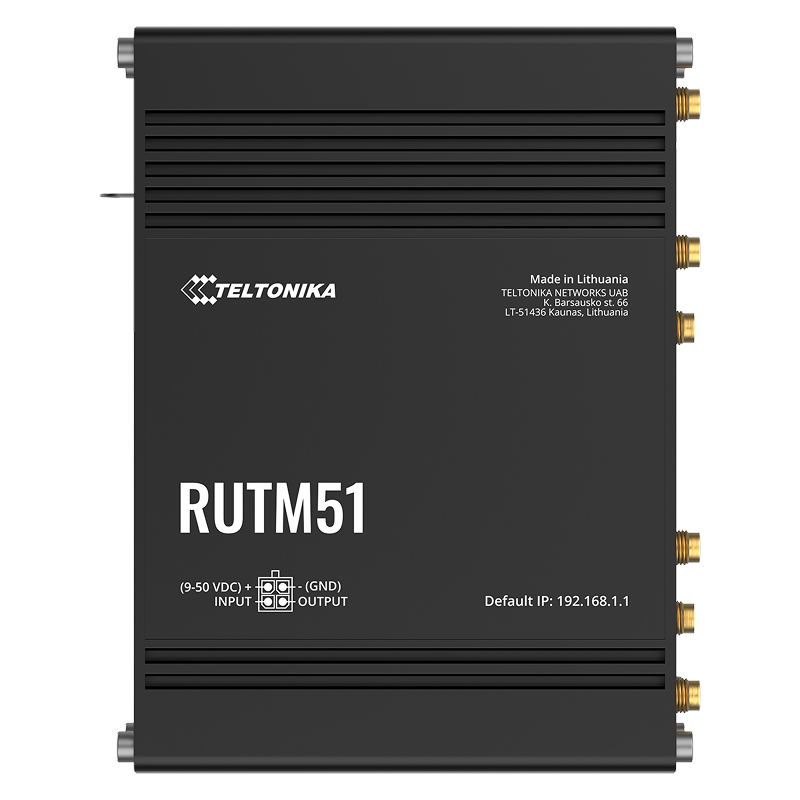
Future-proof
Do you want to know more about the product?
Contact us for a demo or if you have any questions.
